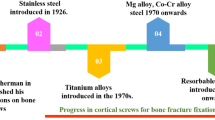Abstract
Internal fixation for bone fractures with rigid metallic plates, screws and pins is a proven operative technique. However, refracture’s have been observed after rigid internal fixation with metal plates and plate fixation has been known to cause localised osteopenia under and near the plate. In the present study, resorbable composites comprising a PLA matrix reinforced with iron doped phosphate glass fibres were investigated. Non-woven random mat laminates of approximately 30% and 45% fibre volume fraction (Vf) were produced, along with unidirectional and 0°–90° samples of approximately 20% Vf. The non-woven composite laminates achieved maximum values of 10 GPa modulus and 120 MPa strength. The 0–90º samples showed unexpectedly low strengths close to matrix value (~50 MPa) although with a modulus of 7 GPa. The UD specimens exhibited values of 130 MPa and 11.5 GPa for strength and modulus respectively. All the modulus values observed were close to that expected from the rule of mixtures. Samples immersed in deionised water at 37°C revealed rapid mechanical property loss, more so for the UD and 0–90º samples. It was suggested that continuous fibres wicked the degradation media into the composite plates which sped up the deterioration of the fibre-matrix interface. The effect was less pronounced in the non-woven random mat laminates due to the discontinuous arrangement of fibres within the composite, making it less prone to wicking. Random mat composites revealed a higher mass loss than the UD and 0°–90° specimens, it was suggested this was due to the higher fibre volume fractions of these composites and SEM studies revealed voidage around the fibres by day 3. Studies of pH of the degradation media showed similar profiles for all the composites investigated. An initial decrease in pH was attributed to the release of phosphate ions into solution followed by a gradual return back to neutral.







Similar content being viewed by others
References
Middleton JC, Tipton AJ. Synthetic biodegradable polymers as orthopaedic devices. Biomaterials. 2000;21:2335–46.
Ferguson SJ, Wyss UP, Pichora DR. Finite element stress analysis of a hybrid fracture fixation plate. Med Eng Phys. 1996;18(3):241–50.
Casper RA, Kelley BS, Dunn RL, Potter AG, Ellis DN. Fibre reinforced absorbable composite for orthopaedic surgery. Polym Mater Sci Eng. 1985;53:497–501.
Kayacan R. The effect of staining on the monotonic tensile mechanical properties of human cortical bone. J Anat. 2007;211:654–61.
Evans FG. Mechanical properties and histology of cortical bone from younger and older men. Anat Rec. 1976;185(1):1–12.
Bosisio MR, Talmant M, Skali W, Laugier P, Mitton D. Apparent Youngs modulus of human radius using inverse finite-element method. J Biomech. 2007;40:2022–8.
Ahmed I, Parsons AJ, Palmer G, Knowles JC, Walker GS, Rudd CD. Weight loss, ion release and initial mechanical properties of a binary calcium phosphate glass fibre/PCL composite. Acta Biomater. 2008;4:1307–14.
Prabhakar RL, Brocchini S, Knowles JC. Effect of glass composition on the degradation properties and ion release characteristics of phosphate glass—polycaprolactone composites. Biomaterials. 2005;26:2209–18.
Andriano KP, Daniels AU. Development of phosphate-microfiber-reinforced poly (orthoester) for absorbable orthopaedic fixation devices. In: Wise DL, editor. Encyclopaedic handbook of biomaterials and bioengineering: part B. Applications. New York: Marcel Dekker; 1995. p. 333–57.
Ahmed I, Cronin PS, Abou Neel EA, Parsons AJ, Knowles JC, Rudd CD. Retention of mechanical properties and cytocompatibility of a phosphate-based glass fibre/polylactic acid composite. J Biomed Mater Res B Appl Biomater. 2008;89(1):18–27.
ASTM Standard D2584-94. Test method for ignition loss of cured reinforced resins. ASTM International. doi:10.1520/D2584-94. www.astm.org.
Carbon fibre—determination of the tensile properties of single filament specimens. International Standard, ISO 11566. BS ISO 11566:1996.
Alpert B, Seligson D. Removal of asymptomatic bone plates used for orthognathic surgery and facial fractures. J Oral Maxillofac Surg. 1996;54:618–21.
Ahmed I, Collins CA, Lewis MP, Olsen I, Knowles JC. Processing, characterisation and biocompatibility of iron-phosphate glass-fibres for tissue engineering. Biomaterials. 2004;25(16):3223–32.
Ahmed I, Parsons AJ, Jones IA, Walker GS, Scotchford CA, Rudd CD. Cytocompatibility and effect of increasing MgO content in a range of quaternary invert phosphate-based glasses. J Biomater Appl. 2010;24(6):555–75. doi:10.1177/0885328209102761.
Burling LD. Novel phosphate glasses for bone regeneration applications. PhD Thesis, University of Nottingham, Nottingham; 2005.
Parsons AJ, Evans M, Rudd CD, Scotchford CA. Synthesis and degradation of sodium iron phosphate glasses and their in vitro cell response. J Biomed Mater Res. 2004;71A:283–91.
Zimmerman MC, Alexander H, Parsons JR, Bajpai PK. The design and analysis of laminated degradable composite bone plates for fracture fixation. In: Vigo TL, Turbak AF, editors. High tech fibrous materials. Washington: ACS Publications; 1991. p. 132–48.
Parsons AJ, Burling LD, Rudd CD, Scotchford CA, Walker GS. The effect of production regime and crucible materials on the thermal properties of sodium phosphate glasses produced from salts. J Biomed Mater Res B Appl Biomater. 2004;71(B):22–9.
Zinck P, Wagner HD, Salmon L, Gerard JF. Are microcomposites realistic models of the fibre/matrix interface? I. Micromechanical modelling. Polymer. 2001;42:5401–13.
Slivka MA, Chu CC. Fiber-matrix interface studies on bioabsorbable composite materials for internal fixation of bone fractures II. A new method using laser scanning confocal microscopy. J Biomed Mater Res. 1997;37:353–62.
Onal L, Cozien-Cazuc S, Jones IA, Rudd CD. Water absorption properties of phosphate glass fibre-reinforced poly-ε-caprolactone composites for craniofacial bone repair. J Appl Polym Sci. 2008;107:3750–5.
Lassila LVJ, Nohrstrom T, Vallittu PK. The influence of short-term water storage on the flexural properties of unidirectional glass fibre-reinforced composites. Biomaterials. 2002;23:2221–9.
Lavengoode RE, Goettler LA. Stiffness of non-aligned fibre reinforced composites. Springfield: National Technical Information Service; 1971.
Acknowledgments
The authors would like to kindly acknowledge EPSRC support under EP/E001904/1.
Author information
Authors and Affiliations
Corresponding author
Rights and permissions
About this article
Cite this article
Ahmed, I., Jones, I.A., Parsons, A.J. et al. Composites for bone repair: phosphate glass fibre reinforced PLA with varying fibre architecture. J Mater Sci: Mater Med 22, 1825–1834 (2011). https://doi.org/10.1007/s10856-011-4361-0
Received:
Accepted:
Published:
Issue Date:
DOI: https://doi.org/10.1007/s10856-011-4361-0




